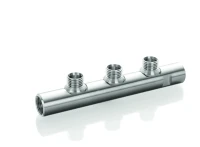- What is an ATEX control box, and how does it relate to hydrogen applications?
- What are the specific requirements and certifications needed for ATEX control boxes used with hydrogen?
- How does an ATEX control box ensure safety in hydrogen environments, particularly concerning explosion protection?
- Can you explain the design considerations for ATEX control boxes in hydrogen-related installations?
- What are the key components and features of an ATEX control box tailored for hydrogen use?
- How does the use of an ATEX control box impact the overall safety and reliability of hydrogen systems?
- Are there any specific installation or operational considerations when integrating an ATEX control box into hydrogen infrastructure?
- What measures are taken to ensure compatibility and functionality between ATEX control boxes and other hydrogen equipment?
- Can you discuss any case studies or real-world examples highlighting the importance and effectiveness of ATEX control boxes in hydrogen applications?
- How do advancements in ATEX control box technology contribute to improving safety standards and operational efficiency in hydrogen industries?
Browse all sensor actuator boxes from leading suppliers on our marketplace!
What is an ATEX control box, and how does it relate to hydrogen applications?
An ATEX control box is a specially designed enclosure used to house electrical and electronic components in environments with explosive atmospheres, such as those found in hydrogen applications. These boxes are built to prevent the ignition of explosive gases , ensuring safe operation in potentially hazardous locations. In the context of hydrogen applications, ATEX control boxes are critical because hydrogen is highly flammable and can create explosive atmospheres when mixed with air. By using ATEX-certified control boxes, industries handling hydrogen can mitigate the risk of explosions, protect equipment, and ensure the safety of personnel working in these environments. These enclosures comply with strict European ATEX directives, which set out safety requirements for equipment used in explosive atmospheres, thus playing a vital role in maintaining safe operations in the hydrogen industry.
What are the specific requirements and certifications needed for ATEX control boxes used with hydrogen?
ATEX control boxes for hydrogen applications must comply with the ATEX directives 2014/34/EU, which outline the essential safety requirements and conformity assessment procedures for equipment used in explosive atmospheres. These control boxes need to be certified for use in specific zones, such as Zone 1 or Zone 2, which are determined based on the likelihood of the presence of explosive atmospheres. Zone 1 indicates a high probability of the presence of explosive gases, while Zone 2 indicates a lower probability.
In addition to ATEX certification, these control boxes should meet relevant IECEx standards, which provide a global framework for equipment used in explosive atmospheres, ensuring international safety and performance consistency. Furthermore, ATEX control boxes often require additional certifications, such as Ingress Protection (IP) ratings, to ensure they are protected against dust and water ingress. The IP rating consists of two digits: the first indicating protection against solids (like dust) and the second indicating protection against liquids (like water). High IP ratings are crucial for ensuring the longevity and reliability of control boxes in harsh environments where hydrogen is present. These combined certifications and standards ensure that the control boxes can operate safely and effectively in potentially hazardous hydrogen applications, minimizing the risk of explosions and ensuring compliance with international safety regulations.
How does an ATEX control box ensure safety in hydrogen environments, particularly concerning explosion protection?
An ATEX control box ensures safety in hydrogen environments by incorporating several design features that prevent the ignition of explosive atmospheres. One of the key elements is the use of flameproof enclosures, which are designed to contain any explosions that might occur within the box, preventing them from igniting the surrounding atmosphere. Additionally, intrinsic safety barriers are employed to limit the electrical and thermal energy available to potentially explosive circuits, ensuring they remain below levels that could cause ignition.
Another crucial safety measure is the use of purging or pressurization systems, which maintain a positive pressure inside the control box with inert gas, typically nitrogen, to keep out any explosive gases . This prevents the formation of an explosive atmosphere inside the enclosure. The materials used in constructing these boxes are non-sparking and often made from metals like stainless steel or aluminum, which do not produce sparks that could ignite hydrogen.
All components within an ATEX control box undergo rigorous testing and certification to ensure they can withstand and operate safely under explosive conditions. This includes tests for temperature ratings, pressure resistance, and compatibility with hydrogen. These stringent safety measures collectively ensure that ATEX control boxes can operate safely and reliably in environments where hydrogen is present, significantly reducing the risk of explosions and ensuring the safety of personnel and equipment.
Can you explain the design considerations for ATEX control boxes in hydrogen-related installations?
Design considerations for ATEX control boxes in hydrogen-related installations focus on several critical aspects to ensure safety and reliability. Firstly, selecting appropriate materials is essential; the materials must resist corrosion and wear, given the potentially harsh and reactive environment where hydrogen is present.
This often involves the use of high-quality gaskets and seals, as well as ensuring that all joints and interfaces are tightly secured. Adequate cooling is also crucial to manage heat dissipation from internal components, preventing overheating that could lead to ignition. This can be achieved through the design of heat sinks, and ventilation systems, or by incorporating materials with good thermal conductivity.
The internal arrangement of components within the control box is designed to minimize potential ignition risks. This involves careful planning to ensure that electrical connections are secure and that there are no loose wires or exposed contacts that could spark.
Overall, these design considerations are aimed at creating a safe, durable, and reliable control box that can operate effectively in the presence of hydrogen.
What are the key components and features of an ATEX control box tailored for hydrogen use?
Key components and features of an ATEX control box for hydrogen applications include:
- Explosion-proof enclosures – assembled and tested by lab
- Safe barriers
- Explosion-proof cable glands and connectors
- Built-in monitoring systems

Example: Enclosure with ATEX certificate
How does the use of an ATEX control box impact the overall safety and reliability of hydrogen systems?
The use of an ATEX control box significantly enhances the safety and reliability of hydrogen systems by implementing stringent measures to prevent explosions and ensure continuous, safe operation. These control boxes are specifically designed to contain potential ignition sources within their ATEX-proof enclosures, thereby preventing sparks or heat from igniting the hydrogen-rich atmosphere outside. This containment of ignition sources is critical in environments where hydrogen can form explosive mixtures with air.
Moreover, ATEX control boxes provide robust monitoring and control capabilities, which are essential for maintaining safe operational conditions in hydrogen production, storage, and distribution processes. They allow for precise monitoring of electrical parameters and environmental conditions inside the enclosure, enabling early detection of potential issues that could lead to safety hazards. This proactive monitoring helps operators take preventive actions to mitigate risks before they escalate.
The reliability of ATEX control boxes is crucial in ensuring the overall safety and integrity of hydrogen systems. By complying with strict ATEX directives and standards, these control boxes undergo rigorous testing and certification processes to verify their ability to withstand and operate safely in potentially explosive atmospheres. This reliability not only protects the equipment from damage but also ensures the safety of personnel working in proximity to hydrogen installations.

Example: ATEX Certified M12 ex Distributor
Are there any specific installation or operational considerations when integrating an ATEX control box into hydrogen infrastructure?
When integrating an ATEX control box into hydrogen infrastructure, several critical considerations must be addressed to ensure safe and effective operation. Firstly, the placement of the control box should avoid areas prone to high mechanical stress or extreme temperatures, as these conditions could compromise the integrity of the equipment. Proper grounding and bonding are essential to mitigate the risk of static discharge, which can be particularly hazardous in hydrogen environments due to its flammability. Regular maintenance and inspections are imperative to confirm the seals and components remain intact and functional, minimizing the potential for leaks or failures that could lead to safety incidents. Equally important is providing comprehensive training for personnel involved in the handling and operation of ATEX equipment, ensuring they understand safety protocols and procedures specific to hydrogen applications. These measures collectively enhance the reliability and safety of integrating ATEX control boxes within hydrogen infrastructure.
What measures are taken to ensure compatibility and functionality between ATEX control boxes and other hydrogen equipment?
To ensure compatibility and functionality between ATEX control boxes and other hydrogen equipment, several measures are implemented. First and foremost, adherence to standardized interfaces and communication protocols is critical. ATEX control boxes are specifically designed to integrate smoothly with other certified hydrogen equipment, ensuring seamless interoperability and consistent performance. Rigorous testing and certification processes validate that all components not only meet safety standards but also work together effectively in hydrogen environments. Moreover, employing modular designs facilitates straightforward upgrades and scalability, accommodating future needs without disrupting existing operations. These measures collectively guarantee that ATEX control boxes operate reliably within hydrogen infrastructure, maintaining both safety and operational efficiency.
Can you discuss any case studies or real-world examples highlighting the importance and effectiveness of ATEX control boxes in hydrogen applications?
Placing the control box near the application requires ATEX certification, which is particularly beneficial for applications such as stack condition monitoring. By positioning the control boxes close to the stacks, we ensure accurate and timely monitoring of the stack health, which directly informs the main controller or controls certain features for enhanced safety and efficiency. Thanks to our customer-specific assembly capabilities, we can build these systems in-house as tailor-made solutions. The real-time monitoring and control provided by these ATEX control boxes significantly reduced the risk of explosions and improved operational efficiency. The use of ATEX-certified components ensured compliance with safety regulations and enhanced the overall reliability of the system.
How do advancements in ATEX control box technology contribute to improving safety standards and operational efficiency in hydrogen industries?
Advancements in ATEX control box technology, such as the integration of IoT and smart diagnostics, contribute to improved safety standards by enabling predictive maintenance and real-time monitoring. Enhanced materials and design techniques increase durability and reduce the risk of component failure. These innovations lead to more efficient operations, lower downtime, and better overall safety in hydrogen industries. Additionally, improved modularity and scalability allow for easier adaptation to evolving industry needs and regulatory requirements.
Content contributed by Weidmüller
The Weidmüller Group Smart Industrial Connectivity: Electrification, automation, digitalisation, electric connectivity, electromobility and renewable energies - markets in which Weidmüller is at home. Founded in 1850, the family-owned company is represented in over 80 countries with production facilities and sales companies. As a global player in electric connection technology, Weidmüller achieved a turnover of more than one billion euros in the 2022 financial year with around 6,000 employees worldwide - around 2,000 of whom work at the company's headquarters in Detmold, in the heart of East Westphalia-Lippe.



